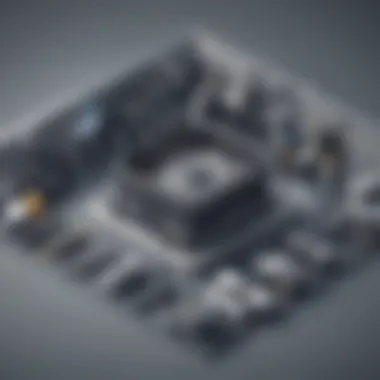Unlocking the Potential of CMMS Software: A Comprehensive Guide


Technological Research Overview
CMMS software, short for Computerized Maintenance Management System software, is revolutionizing maintenance management practices across industries. This advanced technological solution combines the efficient organization of maintenance activities with the power of digital automation. With recent technological innovations driving the landscape of maintenance management, CMMS software stands out as a fundamental tool for enhancing operational efficiency. Businesses are leveraging CMMS software to streamline maintenance processes, reduce downtime, and prolong the lifespan of their assets. The seamless integration of CMMS software into existing systems has resulted in notable improvements in overall business operations.
Moreover, the impact of CMMS software on business operations cannot be overstated. By facilitating proactive maintenance scheduling and asset tracking, CMMS technology enables businesses to ensure optimal equipment performance and minimize unexpected breakdowns. This proactive approach translates to significant cost savings by eliminating costly emergency repairs. Additionally, with the ability to generate detailed reports on maintenance activities and asset performance, CMMS software empowers businesses to make data-driven decisions that enhance operational efficiency and strategic planning.
Looking ahead, future technological trends in CMMS software are intriguing. The evolution of predictive maintenance capabilities within CMMS systems holds substantial promise for businesses seeking to optimize maintenance strategies further. By harnessing the predictive analytics and machine learning algorithms embedded in modern CMMS solutions, businesses can move towards a predictive maintenance model that anticipates and resolves maintenance issues before they escalate. These evolving technological trends position CMMS software as a crucial asset in the realm of maintenance management.
Introduction to CMMS Software
In this article, we delve into the foundational aspects of CMMS software, aiming to provide a comprehensive understanding of its role in streamlining maintenance management processes for optimal business performance. By exploring specific elements, benefits, and considerations related to Introduction to CMMS Software, we aim to equip professionals, entrepreneurs, decision-makers, and tech enthusiasts with indispensable insights into leveraging this advanced technology.
Defining CMMS Software
Overview of CMMS
The Overview of CMMS serves as the cornerstone in understanding the functionality and purpose of this software. It encompasses a detailed look into how CMMS operates, its core features, and the significance of streamlining maintenance activities. The key characteristic of Overview of CMMS lies in its ability to centralize maintenance operations for improved efficiency and organization. Its unique feature lies in real-time monitoring and tracking of maintenance tasks, allowing for proactive management. While its advantages include enhanced productivity and reduced downtime, potential limitations may arise in terms of initial implementation complexity.
Elements of CMMS
The Elements of CMMS encapsulate the fundamental building blocks that constitute this software solution. By examining the core components such as work order generation, asset tracking, and preventive maintenance scheduling, users can grasp the holistic nature of CMMS. The key characteristic of Elements of CMMS is its ability to create a structured framework for maintenance activities, promoting consistency and reliability. Its unique feature lies in customizable workflows tailored to specific business needs. While its advantages comprise streamlined processes and improved resource allocation, potential drawbacks may include a learning curve for new users.
Purpose of CMMS
The Purpose of CMMS underscores the ultimate goal and utility of adopting this software within an organizational setting. It delineates how CMMS enhances operational efficiency, boosts cost-effectiveness, and optimizes asset performance. The key characteristic of Purpose of CMMS is its overarching focus on maximizing maintenance productivity and resource utilization. Its unique feature lies in data-driven decision-making for predictive maintenance and strategic planning. While its benefits encompass increased operational uptime and prolonged asset lifespan, challenges may arise in integration with existing systems.
Evolution of CMMS Solutions
Historical Context
The Historical Context of CMMS Solutions traces the evolution of maintenance management systems from their inception to present-day sophistication. By exploring the historical milestones and technological advancements that shaped CMMS, users gain a comprehensive perspective on its development. The key characteristic of Historical Context lies in illustrating the gradual shift towards digitized maintenance practices and data-driven decision-making. Its unique feature lies in legacy support for traditional maintenance approaches alongside modern digital solutions. While its advantages include a rich historical knowledge base and tested reliability, potential disadvantages may involve compatibility issues with cutting-edge technologies.
Modern Innovations


Key Features of CMMS Software
When delving into the intricate world of CMMS software, understanding the key features is paramount for grasping its significance and utility. These features form the backbone of efficient maintenance management systems, offering a myriad of benefits to businesses across various industries. Asset management capabilities lie at the core of CMMS software, encompassing maintenance scheduling, inventory control, and work order management. These functions are essential for streamlining operations, reducing downtime, and optimizing resource utilization. By harnessing the power of CMMS software's asset management features, organizations can enhance operational efficiency, cut costs, and improve asset performance.
Asset Management Capabilities
Maintenance Scheduling
Maintenance scheduling plays a pivotal role in the effective upkeep of assets within an organization. It involves creating and monitoring maintenance plans for equipment and machinery to ensure optimal functionality and longevity. The key characteristic of maintenance scheduling is its ability to proactively address maintenance needs, preventing unexpected breakdowns and costly repairs. This feature is highly advantageous as it helps organizations stay ahead of maintenance tasks, eliminate downtime, and enhance overall productivity.
Inventory Control
Inventory control within CMMS software is instrumental in managing spare parts and consumables essential for maintenance activities. Efficient inventory control ensures that necessary materials are readily available when needed, minimizing delays in repair and maintenance processes. The unique feature of real-time inventory tracking enables organizations to maintain optimal stock levels, reduce excess inventory costs, and enhance workflow efficiency. However, inadequate inventory control may lead to disruptions in maintenance operations and increased downtime, emphasizing the importance of this feature within CMMS software.
Data Analytics and Reporting
Performance Metrics
Performance metrics form the foundation of data analytics and reporting in CMMS software, offering valuable insights into asset performance and maintenance efficiency. By monitoring key performance indicators (KPIs) such as equipment uptime, maintenance costs, and asset lifespan, organizations can make informed decisions to optimize maintenance practices. The unique feature of predictive analytics allows for anticipating maintenance needs based on historical data, enhancing predictive maintenance strategies and minimizing unexpected equipment failures. While performance metrics provide valuable data for decision-making, improper utilization may result in skewed analysis and ineffective resource allocation.
Predictive Maintenance
Predictive maintenance is a proactive approach to maintenance management facilitated by CMMS software, utilizing data analytics and machine learning algorithms to forecast equipment failures. This advanced feature enhances maintenance planning by identifying potential issues before they escalate, thereby reducing downtime and extending asset lifespan. The key characteristic of predictive maintenance is its ability to forecast maintenance requirements based on equipment performance trends, enabling organizations to schedule maintenance activities strategically and optimize resource utilization. However, the reliance on predictive algorithms may introduce complexities in maintenance operations and require continuous refinement to ensure accuracy and effectiveness.
Integration with IoT and AI
IoT Connectivity
Integration with Internet of Things (IoT) technology empowers CMMS software with real-time data acquisition from connected devices, enabling proactive maintenance interventions and remote monitoring capabilities. The key characteristic of IoT connectivity is its ability to gather vast amounts of operational data, facilitating predictive maintenance and enhancing equipment performance. This unique feature provides organizations with actionable insights and operational visibility, enabling data-driven decision-making to improve maintenance efficiency. However, the complexity of IoT integration and data management may pose challenges in data security and system interoperability, necessitating robust measures to safeguard sensitive information.
AI-driven Insights
AI-driven insights within CMMS software leverage artificial intelligence algorithms to analyze maintenance data, identify patterns, and optimize maintenance strategies. This sophisticated feature enables predictive maintenance planning, anomaly detection, and performance optimization, enhancing overall maintenance efficiency. The key characteristic of AI-driven insights is their capacity to automate maintenance workflows, streamline processes, and reduce manual intervention, leading to cost savings and improved asset reliability. While the benefits of AI integration are substantial, challenges related to data accuracy, algorithm bias, and system compatibility may arise, requiring continuous monitoring and refinement to ensure optimal performance and reliability.


Automation Capabilities
Automation capabilities embedded in CMMS software streamline maintenance processes by automating routine tasks, scheduling maintenance activities, and generating work orders seamlessly. This feature plays a critical role in enhancing operational efficiency, eliminating human errors, and standardizing maintenance protocols. The key characteristic of automation capabilities is their ability to enhance task automation, minimize manual intervention, and expedite maintenance workflows, resulting in time and cost savings for organizations. The unique feature of automated maintenance alerts and notifications ensures timely response to maintenance requests, reducing downtime and enhancing asset performance. However, challenges related to system integration, algorithm complexity, and user adoption may pose obstacles to leveraging the full potential of automation capabilities within CMMS software.
Implementation Strategies for CMMS Software
In the realm of implementing Computerized Maintenance Management System (CMMS) software, adherence to well-thought-out strategies is paramount for successful integration. This section will expound on the critical aspects, benefits, and considerations revolving around the implementation of CMMS software. By meticulously planning the execution of CMMS software, organizations can enhance operational efficiency, reduce costs, and optimize asset performance.
Deployment Planning
Needs Assessment
When embarking on the journey of CMMS software implementation, conducting a comprehensive needs assessment is fundamental. This stage involves assessing the specific requirements and challenges faced by an organization in the realm of maintenance management. The needs assessment process provides insights into gaps in existing systems, identifies functional necessities, and sets the foundation for selecting a suitable CMMS solution. Its meticulous nature ensures that the chosen software aligns with the organization's unique needs, making it a crucial step in achieving successful implementation. Despite its meticulous nature, the needs assessment process might be time-consuming and require significant input from various stakeholders, potentially leading to delays in implementation.
Vendor Selection
Selecting the right vendor for CMMS software is a decision that significantly influences the success of the implementation process. The choice of vendor encompasses evaluating factors such as vendor reputation, product features, scalability, support services, and overall compatibility with the organization's objectives. Opting for a reputable vendor with a track record of successful implementations can mitigate risks and instill confidence in the chosen solution. However, the vendor selection process may present challenges in terms of aligning organizational preferences with available vendor offerings, necessitating thorough research and comparative analysis to make an informed decision.
Training Programs
Effective training programs play a pivotal role in ensuring the seamless adoption and utilization of CMMS software within an organization. These programs are designed to equip users with the necessary skills and knowledge to leverage the full potential of the software, enabling them to execute maintenance tasks efficiently. The key characteristic of training programs lies in their ability to bridge the gap between theoretical understanding and practical application, empowering users to navigate the software with confidence. Despite the undeniable benefits of training programs in enhancing user proficiency, challenges may arise in terms of resource allocation and scheduling training sessions to accommodate diverse user needs.
Change Management Processes
Stakeholder Engagement
Engaging stakeholders throughout the CMMS implementation process is essential for garnering support, ensuring alignment with organizational goals, and fostering a culture of collaboration. Stakeholder engagement involves involving key individuals from various departments who will be affected by the implementation, including maintenance teams, IT personnel, and management. By soliciting input, addressing concerns, and incorporating feedback from stakeholders, organizations can enhance the chances of successful CMMS adoption. Although stakeholder engagement brings overarching benefits, managing diverse stakeholder expectations and soliciting active participation can present challenges requiring strategic communication and mediation.
Organizational Alignment
Aligning the implementation of CMMS software with organizational objectives and cultural norms is crucial for seamless integration and sustained adoption. Organizational alignment entails ensuring that the goals and outcomes of implementing CMMS software resonate with the broader mission and vision of the organization. This alignment fosters a sense of purpose among employees, encourages buy-in from stakeholders, and paves the way for a smooth transition towards a more efficient maintenance management system. However, achieving organizational alignment may demand thorough change management strategies, effective communication channels, and cultural transformation efforts to overcome resistance and ensure widespread acceptance.
Continuous Improvement


Embracing a culture of continuous improvement post-CMMS implementation is imperative for maximizing the benefits reaped from the software and adapting to changing organizational needs. Continuous improvement involves a cyclic process of evaluating system performance, identifying enhancement opportunities, implementing refinements, and measuring outcomes. The key characteristic of continuous improvement lies in its iterative nature, allowing organizations to evolve their maintenance management processes iteratively. Despite the inherent advantages of continuous improvement, challenges may arise in terms of resource allocation, resistance to change, and maintaining momentum for ongoing enhancements, underscoring the need for dedicated efforts towards organizational growth and adaptability.
Performance Evaluation Metrics
KPI Tracking
Tracking Key Performance Indicators (KPIs) serves as a foundational element for assessing the effectiveness of CMMS software and measuring the impact on maintenance management operations. KPI tracking involves defining relevant metrics, setting performance benchmarks, and monitoring progress towards achieving operational goals. The key characteristic of KPI tracking is its ability to provide quantifiable insights into system performance, enabling data-driven decisions and strategic adjustments. While KPI tracking offers valuable insights, challenges may arise in terms of defining actionable KPIs, ensuring data accuracy, and interpreting metrics to derive actionable insights, reinforcing the need for clarity, precision, and consistency in tracking performance.
User Feedback
Incorporating user feedback mechanisms within the CMMS software ecosystem is essential for capturing user experiences, addressing usability issues, and driving continuous enhancement. User feedback entails gathering input from system users regarding their interactions with the software, soliciting suggestions for improvement, and implementing user-driven changes. The unique feature of user feedback lies in its direct contribution to software usability and user satisfaction by aligning software functionalities with user expectations. However, integrating user feedback processes may pose challenges in terms of feedback processing, prioritizing enhancements, and balancing user requests with system capabilities, necessitating a systematic approach to feedback management and iterative development.
ROI Analysis
Conducting Return on Investment (ROI) analysis post-CMMS implementation is integral for evaluating the economic viability, performance gains, and tangible benefits derived from the software. ROI analysis involves quantifying the costs incurred during implementation and operation, juxtaposed with the tangible returns and efficiency gains achieved through CMMS software usage. The key characteristic of ROI analysis lies in its ability to contextualize the financial implications of software adoption, guiding future investment decisions and substantiating the value proposition of CMMS software. Nevertheless, conducting ROI analysis may present challenges in terms of data collection, establishing baselines for comparison, and attributing benefits to specific software functionalities, underscoring the need for robust evaluation frameworks and strategic measurement mechanisms.
Future Trends in CMMS Technology
In the realm of CMMS technology, looking towards the future is crucial for staying ahead in maintenance management. The infusion of artificial intelligence (AI) and machine learning into CMMS systems is revolutionizing the industry. These innovations bring predictive analytics to the forefront, enabling organizations to anticipate maintenance needs accurately. Predictive analytics harnesses historical data to forecast potential equipment failures, optimizing maintenance schedules and reducing downtime. Its key characteristic lies in its proactive approach, moving away from reactive maintenance practices. This shift towards predictive maintenance is a popular choice in the industry due to its ability to enhance operational efficiency and prolong asset lifespan. However, one of the challenges of predictive analytics is the need for high-quality data input to generate accurate predictions.
The integration of autonomous maintenance within CMMS systems transforms the way maintenance tasks are performed. Autonomous maintenance empowers machines to self-diagnose issues and even execute repairs autonomously, minimizing human intervention and streamlining the maintenance process. Its unique feature lies in the ability to streamline routine maintenance tasks, liberating maintenance teams to focus on more complex issues. While autonomous maintenance offers significant advantages in reducing labor costs and improving operational efficiency, potential drawbacks include the initial investment in advanced technologies and the need for skilled personnel to oversee autonomous operations.
Another promising aspect of future CMMS technology is cognitive computing. This advanced technology simulates human thought processes using artificial intelligence algorithms, enabling CMMS systems to learn and adapt to new situations continuously. The key characteristic of cognitive computing is its ability to comprehend complex data patterns and make informed decisions without explicit programming. Incorporating cognitive computing into CMMS allows for sophisticated problem-solving capabilities and the customization of maintenance strategies based on evolving needs. While cognitive computing presents unparalleled benefits in enhancing maintenance decision-making and operational performance, challenges may arise in integrating complex cognitive systems seamlessly into existing CMMS infrastructure.
Cloud-Based Solutions
Cloud-based solutions play a critical role in modern CMMS technology, offering unprecedented scalability and flexibility to businesses. Scalability is a defining aspect of cloud-based solutions, allowing organizations to adjust system capacity according to their evolving needs seamlessly. Cloud solutions accommodate varied workloads and data volumes, ensuring optimal performance without the need for extensive hardware investments. The unique feature of scalability lies in its ability to expand or contract resources on-demand, providing cost-effective solutions for businesses of all sizes. While scalability enhances operational agility and cost-efficiency, organizations must consider data security and privacy implications when migrating to cloud-based CMMS platforms.
Flexibility is another core attribute of cloud-based CMMS solutions, enabling organizations to customize system functionalities to suit their unique requirements. The key characteristic of flexibility lies in its adaptability to diverse business processes and industry-specific workflows. Cloud solutions offer modular architectures that facilitate seamless integration with existing software applications, promoting operational cohesion and data consistency. The unique feature of flexibility enables organizations to align CMMS systems with changing operational demands effectively. However, maintaining flexibility may pose challenges in terms of configuring complex system integrations and ensuring streamlined data exchange between various platforms.
Security measures are paramount in cloud-based CMMS solutions to safeguard critical maintenance data and protect system integrity. Robust security measures involve encryption protocols, access controls, and regular system audits to mitigate potential cyber threats. The key characteristic of security measures is their proactive approach to identifying and addressing vulnerabilities before they pose significant risks. Implementing advanced security measures ensures data confidentiality, integrity, and availability within cloud-based CMMS environments. While robust security measures enhance data protection and system reliability, organizations must stay vigilant against emerging cybersecurity threats and adhere to best practices for secure cloud usage.
Mobile Applications for Mobility
Mobile applications are reshaping maintenance management by providing workforce mobility and real-time connectivity for field operations. Field operations benefit significantly from mobile applications by enabling maintenance teams to access CMMS functionalities remotely. The key characteristic of field operations on mobile apps is the ability to streamline work order management, asset tracking, and technician communication in real-time. Mobile applications offer unique features such as offline functionality, GPS tracking, and barcode scanning, enhancing field productivity and resource optimization. Despite the advantages of field operations via mobile apps, challenges may arise in ensuring seamless synchronization between mobile devices and centralized CMMS databases.
Real-time updates through mobile applications revolutionize maintenance communication by delivering instantaneous notifications and status alerts to stakeholders. The key characteristic of real-time updates is their ability to facilitate timely decision-making and enhance situational awareness for maintenance activities. Real-time updates offer unique features like push notifications, live data syncing, and automated task reminders, improving operational efficiency and reducing response times. While real-time updates boost communication transparency and information dissemination, organizations must address connectivity issues and data synchronization concerns to leverage these features effectively.
Remote access capabilities in mobile applications empower maintenance professionals to manage CMMS tasks effortlessly from any location. The key characteristic of remote access is its provision of secure and convenient connectivity to CMMS systems using mobile devices. Remote access offers unique features like cloud synchronization, remote control functionalities, and encrypted data transmission, enabling seamless interaction with CMMS platforms. While remote access enhances operational flexibility and collaboration among maintenance teams, concerns may arise regarding data security and authorized access protocols in mobile environments.







